Featured Application
Resource and environmental effects of the Tibetan Plateau.
Abstract
Precursory earth tidal triggering is believed to influence earthquake timing preferentially when a region is critically stressed. However, whether and how the recurrence of aftershocks after a giant earthquake is affected by tidal triggering remains perplexing. To provide insight into this study, we utilized the Schuster test to explore the tidally induced stress variation correlated with the 2011 Mw 9.0 Tohoku earthquake aftershock sequence by determining the tidal phase angle at the occurrence time of events and the periodic characteristics of the aftershocks. Our results show that the aftershocks were triggered by short-period tides, including semidiurnal and diurnal tides. The rupture associated with the mainshock likely resulted in a critical stress state in the focal region, which is conducive to tidal triggering. We subdivided the aftershock catalog into several subsets, using a depth of 30 km and a magnitude of 5 as discriminators. The analysis of these subsets reveals that weaker and deeper earthquakes are best correlated with Earth tides, which will be helpful to investigate the mechanisms of tidal correlation.
1. Introduction
The 2011 Mw 9.0 Tohoku earthquake occurred along the northeast Japan subduction zone, which is a region in which five main plates interact (Figure 1) (e.g., [1,2]). The Pacific Plate subducts under the Eurasian Plate and the Okhotsk Plate at a speed of 8–10 m per century along the Kuril Trench and the Japan Trench (e.g., [3,4]), located off the east coast of Honshu, Japan. As the cold Pacific plate underthrusts beneath Japan, the spatial variation in friction along the plate boundaries results in strain in the rocks around the locked area of megathrust faults, which leads to energy accumulation around the stuck regions (e.g., [5]). On the other hand, the East–West convergence of northeastern Japan (Okhotsk plate) and the Amur plate form an incipient subduction zone on the eastern margin of the Japan Sea (e.g., [6,7,8]). The structure of this area is further complicated by the collision between the Kurile arc and the Japanese arc in the Hidaka collision zone [3], which has produced frequent moderate to large earthquakes with complicated mechanisms, such as tectonic loading and thermal and lithological features on the edge of the plate [9]. The trench subduction zone of Japan has become the region with the highest frequency and intensity of seismic activity around the Pacific Ocean. In the trench subduction zone of Japan, there is quite a long record of large earthquakes. Except for the M~8.5 Jogan earthquake (year 869), no earthquakes with M ≥ 8.5 were recorded prior to the Mw 9.0 Tohoku event [10]. These complicated tectonic settings have featured Tohoku as a popular area for studying the mechanics and mechanisms of the occurrences of earthquakes.
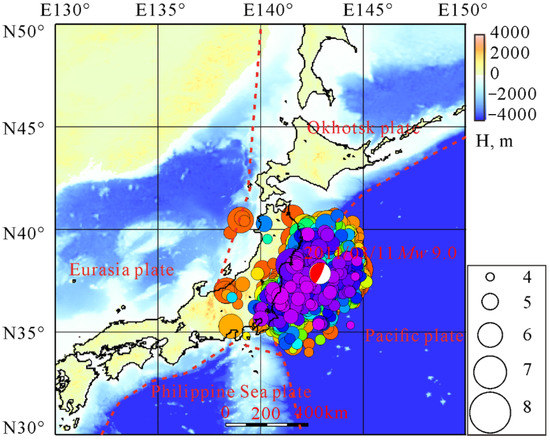
Figure 1.
Seismotectonics of the study region. Aftershocks from the United States Geological Survey (USGS) catalog from 11 March 2011 to 10 April 2011 are shown by colored dots with radii proportional to the magnitude. The Mw 9.0 focal mechanism is based on Harvard Centroid Moment Tensor (CMT) results.
Previous studies have suggested that aftershocks can be triggered by static stress changes and dynamic forcing following a large earthquake (e.g., [11,12]). Earthquake triggering disturbs the existing stress state, which can be a condition of the critical state. Earthquake triggering by Earth tides is also a possibility, since tides are always present and induce an oscillatory deformation of the solid Earth. An especially high correlation with tides has been shown for aftershocks, earthquake swarms, and earthquakes occurring in subduction zones and volcanic areas [13,14,15,16], all of which consist of a large number of small shocks. The Mw 9.0 Tohoku megathrust earthquake occurred along the subduction boundary, where the tidal triggering of seismic activities has been observed by numerous previous studies (e.g., [14,17,18,19]). Hence, this very large earthquake highlights the critical need for and provides the chance for a better understanding of the tidal triggering mechanism.
Although the magnitude of the tidal stress is much smaller than that of a typical stress drop during an earthquake, the loading rate of the tidal stress is greater than that of the tectonic stress accumulation. Tidal stress can cyclically load and unload the crust, with various periods, and affect the time of occurrence of an earthquake to some extent [20]. Not only the amplitude but also the periodic oscillation of the tidal stress may play a role in the tidal triggering of earthquakes [17,18,21,22]. Many studies have attempted to explore the correlation between Earth tides and earthquake occurrences [15,23,24,25,26,27,28,29,30], and some studies have revealed positive tidal correlations [13,16,20,27,31,32]. A popular method is to calculate the tidal phase angle of each earthquake and obtain its distribution. Following previous studies, each event is assigned a phase angle on a linear scale from −180° to 180° corresponding to the occurrence time, where 0° and ±180° represent the maximum and minimum values of the tidal load in a tidal cycle, respectively [17,18]. A focused distribution of earthquakes occurring near a certain phase angle indicates a tidal correlation and the presence of some dominant phase angles. If the tidal phase angles show a random distribution, then there is no tidal correlation [14,17,18]. This test method is suitable for study areas with homogeneous seismicity, while nonuniform seismic activities (such as aftershocks) may affect the judgment of the correlation [33,34]. In one study [34], a new method to analyze the possible periodic characteristics of aftershocks was proposed.
In this study, we aim to investigate the correlation between Earth tides and earthquake occurrences on the basis of the 2011 Mw 9.0 Tohoku earthquake aftershocks. Previous work has revealed tidal triggering in the aftershock sequence of the Ms 8.0 Wenchuan earthquake on 12 May 2008 (e.g., [35]). The Wenchuan earthquake was an inland event, while the Tohoku earthquake occurred offshore in the Pacific Ocean. The tide of solid Earth and the ocean were both included. First, the Schuster test is used to explore the tidal correlation. Then, the Schuster spectrum method is used to analyze the seismic sequence to obtain possible periodicity in the Schuster spectrum of aftershocks. Furthermore, it is discussed whether the tidal forces corresponding to these periods have played a significant role in triggering earthquakes. On this basis, a preliminary discussion is provided on the characteristics of the possible tidal triggering of the Mw 9.0 earthquake aftershocks.
2. Data and Methods
2.1. Data Selection
Earthquake data of the 2011 Tohoku event are available in the USGS earthquake database (https://earthquake.usgs.gov/earthquakes/search/, accessed on 1 July 2022). To fully analyze the correlation between all aftershocks and Earth tides, an earthquake catalog from 11 March 2011 to 10 April 2011 was selected in a rectangular region between latitudes 34° N–41° N and longitudes 138° E–146° E. In this area, 3058 (M > 4.0) earthquakes have been recorded by the USGS in the month following the mainshock. The spatial distribution and magnitude–time (M–t) maps of the selected seismic sequences are shown in Figure 1 and Figure 2, respectively. Seismic activity was still occurring at a higher level one month after the mainshock. The catalog is subdivided into several subsets using a depth of 30 km and a magnitude of 5 as thresholds (Table 1) to test tidal triggering variations that would depend on the earthquake magnitude and depth. The number of earthquakes included in each subset is listed in Table 1; these numbers are deemed sufficient to run the tidal statistical test.
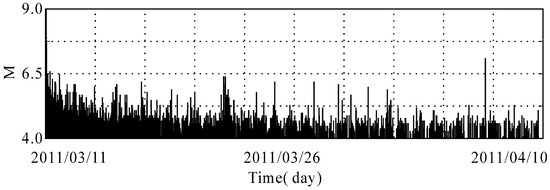
Figure 2.
M–t plot of the Mw 9.0 earthquake sequence in Japan in 2011.

Table 1.
Number of earthquakes in different subsets.
2.2. Methods
Since the aftershock dataset contains a sequence of events with an irregular spatial pattern, it is not suitable for one method to detect periodicities. In this paper, we use the Schuster test and the Schuster spectrum to evaluate the tidal correlation of the aftershocks. The Schuster test is utilized to explore the preliminary tidal correlation, as the existence of clusters may affect the correlation and yield an apparent tidal correlation [14]. Then, the Schuster spectrum method is utilized not only to verify the results obtained by the Schuster test but also to provide further insight.
The Schuster test consists of calculating the distribution of phase angles of all earthquakes [14,18,36]. First, for each earthquake, a tidal phase angle is assigned using a linear scale from −180° to 180°, according to its time of occurrence and the location of the hypocenter. At this scale, the maximum and minimum tidal loads in the tidal cycle are represented by 0° and ±180°, respectively [17,18]. If the tidal phase angles for earthquakes concentrate around a particular angle, a dominant phase angle is identified. A p-value is used to represent the level of significance of the correlation, where a value < 5% indicates statistical significance [14,15,30].
For further verification, the Schuster spectrum is calculated to evaluate the effect of aftershock clustering on Schuster’s p-value (the level of significance of the correlation). The Schuster spectrum method [34] is based on the Schuster statistical test. The Schuster spectrum is a tool that detects any unknown periodicity in the catalog and analyzes any seismic activity rate [34]. By obtaining the Schuster spectrum of the subsequent seismicity, we can identify the significant periodic components of the aftershocks through a stacking process. To obtain a Schuster spectrum of a nonuniform time series, N repetitions of the Schuster statistical test are needed. If an earthquake sequence (the signal) has a duration of t and a period of T, the periodic sampling is calculated as [34]:
where ε is a coefficient, and is the frequency. The increment of frequency is thus a constant, i.e., . To calculate a Schuster spectrum between the periods and , the Schuster test must be run N times.
The value of ε determines whether the sampling period is reasonable. An optimal value exists for ε, and Ader and Avouac [34] suggest . By taking ε equal to , the expected value of the minimum Schuster’s p-value in a spectrum containing N independent tests is:
It is worth noting that the p-value in Schuster’s statistical test is less than 5%, which indicates that there is a tidal correlation, and the threshold value is fixed. In Equation (3), the expected threshold of the Schuster spectrum related to the selected period of each Schuster test (i.e., the expected threshold) is variable. In the analysis of a Schuster spectrum [34], a 95% confidence level can be used as a criterion.
In this study, strain tensors caused by solid earth tides and ocean loading are calculated using the GOTIC2 program [37].
3. Results
3.1. Frequency Distributions of the Tidal Phase Angles
Identifying the fault plane for each aftershock is difficult; therefore, the normal stress and the shear stress for each aftershock could not be calculated. For this reason, the volumetric strain is used to perform the statistical analysis. Figure 3, Figure 4 and Figure 5 show the results of the Schuster test using all earthquake data or the various subsets listed in Table 1. The histogram in the Figure shows the frequency distribution of the phase angles. Earthquakes are gathered into a 15° wide phase angle window. The sinusoidal curve shows the least squares method according to the frequency distribution [14,15]. In Figure 3, Figure 4 and Figure 5, a small p-value (<5%) is obtained from the frequency distribution. The p-values obtained for all the subsets are also listed in Table 2. The p-values are slightly different across the nine subsets.
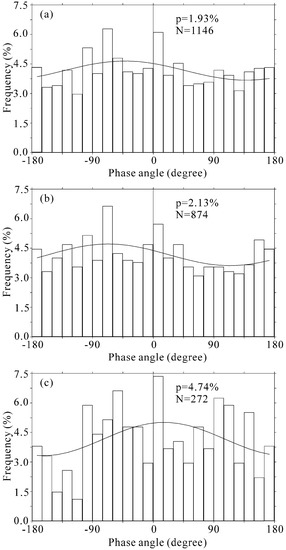
Figure 3.
Frequency distributions of the tidal phase angles for the three subsets with any depth and different cutoff magnitudes: (a) any M; (b) 0 < M < 5; (c) M ≥ 5. The solid curves in (a–c) are sinusoidal functions fitting the distributions.
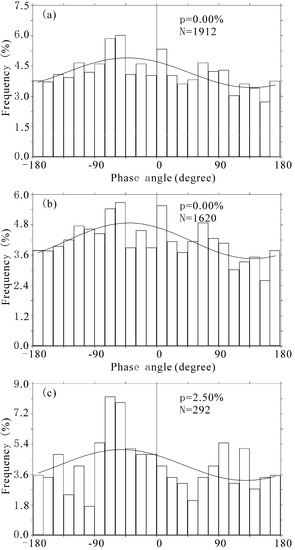
Figure 4.
Frequency distributions of the tidal phase angles for the three subsets with 0 < depth < 30 km and different cutoff magnitudes: (a) any M; (b) 0 < M < 5; (c) M ≥ 5.

Figure 5.
Frequency distributions of the tidal phase angles for the three subsets with a depth ≥ 30 km and different cutoff magnitudes: (a) any M; (b) 0 < M < 5; (c) M ≥ 5.

Table 2.
Statistical significance of the earthquake distributions from the Schuster test.
3.2. Correlation between Earth Tides and Aftershock Sequence
Our results demonstrate a clear tidal correlation between Earth tides and aftershock sequences, with levels of significance greater than 95%. In particular, deep earthquakes (depth > 30 km) are more easily triggered by tides than shallow earthquakes, as shown in Figure 5, with p-values close to zero (Table 1). Moreover, our results also show that the small-magnitude (M < 5.0) earthquakes shown in Figure 3b, Figure 4b and Figure 5b are more easily triggered by tides.
Encouraged by the results of the Schuster test, we use the Schuster spectrum to evaluate the effect of aftershock clustering on Schuster’s p-value and detect tidal periodicities. The Schuster spectrum is useful for detecting unknown periodicities; thus, it is an effective tool for assessing whether a dataset contains periodic patterns. As shown in Figure 6, some obvious periodicities, including diurnal and semidiurnal periodicities, were observed. This shows that the tidal phase distribution of the aftershocks is mainly controlled by diurnal and semidiurnal periods. In summary, the aftershocks show a significant tidal correlation in both tests.
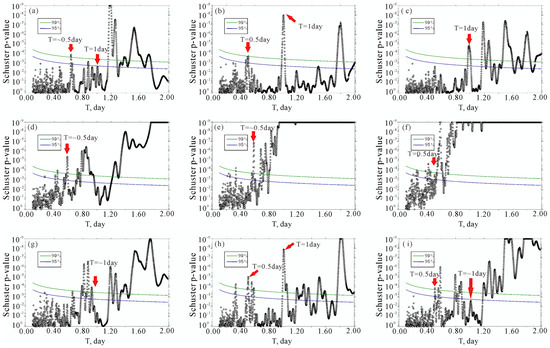
Figure 6.
Schuster spectra for different subsets: (a) 0 < M < 5 and 0 < depth < 30 km; (b) M ≥ 5 and 0 < depth < 30 km; (c) any M and 0 < depth < 30 km; (d) 0 < M <5 and depth ≥ 30 km; (e) M ≥ 5 and depth ≥ 30 km; (f) any M and depth ≥ 30 km; (g) 0 < M < 5 and any depth; (h) M ≥ 5 and any depth; (i) any M and any depth. The red arrows indicate distinct periods; 99% and 95% confidence levels correspond to 1% and 5% of the minimum Schuster p-value, respectively.
4. Discussion
The Schuster test, which was utilized to statistically analyze the times of occurrences of earthquakes, revealed a significant correlation between the aftershocks of the 2011 Mw 9.0 Tohoku earthquake, Japan, and Earth tides. Furthermore, the Schuster spectrum showed that the most obvious periods in the datasets are 0.5 days and 1 day. This is consistent with the period of diurnal and semidiurnal tides, indicating that the seismic activity that followed the Mw 9.0 mainshock might have been triggered by Earth tides. The period of the Earth tide depends on the relative location of the Moon, the Sun, and the Earth. Thus, it is affected by (1) the period of rotation of the Earth about its axis, which is approximately 24 h; (2) the period of revolution of the Moon around the Earth, and the variation of the declination and the distance between the center of the Moon and the Earth, which is approximately one month; and (3) the period of the revolution of the Earth around the Sun, which is one year.
The results of this paper show that short-period tides can trigger seismicity in Japan, consistent with the conclusions of related studies [25]. When the tidal force acts on the focal area, the stress state of the focal area and the stage of earthquake nucleation are the key factors determining the tidal triggering effect [38,39,40]. If the stress state of the focal area is in a stage of critical instability [11,39,41], the oscillatory loading of the tidal force will promote seismicity. In other words, when the stress in the focal area is in a critical state, the tidal stress might increase the crustal stress slightly, possibly triggering an earthquake. Earth tides vary in space and time; thus, they only trigger earthquakes under favorable conditions. Aftershock activity following a mainshock is the most vulnerable condition for earthquakes triggered by short-period tides. This may be due to the occurrence and stress accumulation of the mainshock. The stress in the earthquake area accumulates, which is conducive to earthquake triggering by the tidal force.
The results of this paper do not reveal a correlation between the aftershocks of the Mw 9.0 Tohoku earthquake and long-period Earth tides. This is due to the attenuation speed and the duration of the aftershock sequence. On the other hand, semidiurnal and diurnal tides show more obvious oscillatory characteristics. The influence of long-period tides on regional seismicity and its related conditions needs to be studied in detail on a long-duration earthquake sequence.
For the physical mechanism of tidal triggering, more detailed aftershock data are needed, including the focal mechanism of the aftershocks. The same tidal stress tensor might have either positive or negative effects on the shear fracture. Moreover, the type of seismic fault has an important influence on tidal triggering. Therefore, analyses that neglect the focal mechanism and fault type cannot contribute substantially to the understanding of the physical mechanism of earthquake tide triggering.
We also found that the tidal correlation depends on the earthquake magnitude and the focal depth. Small events (M < 5.0) and deep events (depth > 30 km) are more easily triggered by tides. It is difficult to clearly explain the effect of the focal depth. We have briefly discussed that changes in stress or strain at large depths are not significantly reduced compared to those on Earth’s surface in this region. The mechanism of the magnitude dependence on tidal triggering has been discussed by Tanaka et al. [14], which is a good candidate to interpret the phenomenon of the Mw 9.0 Tohoku earthquake aftershocks.
5. Conclusions
In this paper, we studied the temporal correlation between Earth’s tides and the aftershock sequence of the 2011 Mw 9.0 Tohoku earthquake, which occurred in the Northeast Subduction Zone of Japan. We define the tidal phase angle of each earthquake and use the Schuster test method to evaluate whether the phase angle is concentrated around a specific angle. The test provides a p-value indicating the significance level for which the null hypothesis is rejected, i.e., that earthquakes occur randomly, irrespective of the phase angle of the tide. In addition, we use the Schuster spectrum to evaluate the impact of aftershock clustering on Schuster’s p-value. The results are as follows.
(1) Aftershocks have been triggered by short-period tides, including semidiurnal and diurnal tides.
(2) The rupture associated with the mainshock likely resulted in a critical stress state in the focal region, which is conducive to tidal triggering.
(3) Smaller and deeper earthquakes are best correlated with Earth tides, which will be helpful to investigate the mechanisms of tidal correlation.
Author Contributions
C.X. designed the study, performed the modeling, and interpreted the results. C.X., Y.Z. and Y.J. wrote the manuscript. W.Z. and R.Q. provided comments to improve the manuscript. All authors discussed the results and interpretations and participated in writing the paper. All authors have read and agreed to the published version of the manuscript.
Funding
This study was supported by the National Natural Science Foundation of China (Grant No. 41964001), the Second Tibetan Plateau Scientific Expedition and Research Program (2019QZKK0708), State Key Laboratory of Earthquake Dynamics (Project No. LED2019B04), and the CAS Pioneer Hundred Talents Program.
Institutional Review Board Statement
Not applicable.
Informed Consent Statement
Not applicable.
Data Availability Statement
Data are available in the Figures and Tables or from the authors upon reasonable request.
Acknowledgments
We are grateful to the two anonymous reviewers for their constructive comments that allowed us to improve this manuscript. We also thank Xinglin Lei from the Geological Survey of Japan for sharing the GeoTaos_Map software and constructive comments on this work.
Conflicts of Interest
All the authors listed certify that they have no involvement in any organization or entity with any financial interest (including honoraria; educational grants; participation in speakers’ membership, bureaus, consultancies, stock ownership, employment, or other equity interest; and patent-licensing arrangements or expert testimony) or nonfinancial interest (including professional or personal relationships, knowledge or beliefs, affiliations) in the subject materials or matter discussed.
References
- Wei, D.; Seno, T. Determination of the Amurian plate motion. Mantle Dyn. Plate Interact. East Asia 1998, 27, 337–346. [Google Scholar]
- Taira, A. Tectonic evolution of the Japanese island arc system. Annu. Rev. Earth Planet. Sci. 2001, 29, 109–134. [Google Scholar] [CrossRef]
- DeMets, C. Oblique convergence and deformation along the Kurile and Japan trenches. J. Geophys. Res. 1992, 97, 17615–17625. [Google Scholar] [CrossRef]
- Ghimire, S.; Tanioka, Y. Spatial distribution of stress and frictional strength along the interplate boundary in northern Japan and its correlation to the locations of large earthquakes. Tectonophysics 2011, 511, 1–13. [Google Scholar] [CrossRef]
- Thorne, L. A review of the rupture characteristics of the 2011 Tohoku-oki Mw 9.1 earthquake. Tectonophysics 2018, 733, 4–36. [Google Scholar]
- Fitch, T.J. Plate convergence, transcurrent faults, and internal deformation adjacent to southeast Asia and western Pacific. J. Geophys. Res. 1972, 77, 4432–4460. [Google Scholar] [CrossRef]
- Nakamura, K. Possible nascent trench along the eastern Japan Sea as the convergent boundary between Eurasian and North American plates. Bull. Earthq. Res. Inst. Univ. Tokyo 1983, 58, 711–722. [Google Scholar]
- Tamaki, K.; Honza, E. Incipient subduction and obduction along the eastern margin of Japan Sea. Tectonophysics 1985, 119, 381–406. [Google Scholar] [CrossRef]
- Ozel, N.; Moriya, T. Focal mechanism of intermediate-depth earthquakes beneath southern Hokkaido, Japan, implications of the double seismic zone. Pure Appl. Geophys. 2003, 160, 2279–2299. [Google Scholar] [CrossRef]
- Minoura, K.; Imamura, F.; Sugawara, D.; Kono, Y.; IwashIta, T. The 869 Jogan tsunami deposit and recurrence interval of large-scale tsunami on the Pacific coast of northeast Japan. J. Nat. Disaster Sci. 2001, 23, 83–88. [Google Scholar]
- Harris, R.A. Introduction to special section: Stress triggers, stress shadows, and implications for seismic hazard. J. Geophys. Res. 1998, 103, 24347–24358. [Google Scholar] [CrossRef]
- Peng, G.; Lei, X.; Wang, G.; Jiang, F. Precursory tidal triggering and b value variation before the 2011 Mw 5.1 and 5.0 Tengchong, China earthquakes. Earth Planet. Sci. Lett. 2021, 574, 117167. [Google Scholar] [CrossRef]
- Klein, F.W. Earthquake swarms and the semidiurnal solid earth tide. Geophys. J. R. Astron. Soc. 1976, 45, 245–295. [Google Scholar] [CrossRef]
- Tanaka, S.; Ohtake, M.; Sato, H. Evidence for tidal triggering of earthquakes as revealed from statistical analysis of global data. J. Geophys. Res. 2002, 107, 2211. [Google Scholar] [CrossRef] [Green Version]
- Tanaka, S.; Ohtake, M.; Sato, H. Spatiotemporal variation of the tidal triggering effect on earthquake occurrence associated with the 1982 South Tonga earthquake of Mw 7.5. Geophys. Res. Lett. 2002, 29, 16. [Google Scholar] [CrossRef]
- Tolstoy, M.; Vernon, F.L.; Orcutt, J.A.; Wyatt, F.K. Breathing of the seafloor: Tidal correlations of seismicity at Axial volcano. Geology 2002, 30, 503–506. [Google Scholar] [CrossRef]
- Tanaka, S.; Sato, H.; Matsumura, S.; Ohtake, M. Tidal triggering of earthquakes in the subducting Philippine Sea plate beneath the locked zone of the plate interface in the Tokai region, Japan. Tectonophysics 2006, 417, 69–80. [Google Scholar] [CrossRef]
- Tanaka, S. Tidal triggering of earthquakes precursory to the recent Sumatra megathrust earthquakes of 26 December 2004 (Mw 9.0), 28 March 2005 (Mw 8.6), and 12 September 2007 (Mw 8.5). Geophys. Res. Lett. 2010, 37. [Google Scholar] [CrossRef]
- Tanaka, S. Tidal triggering of earthquakes prior to the 2011 Tohoku-Oki earthquake (Mw 9.1). Geophys. Res. Lett. 2012, 39, L00G26. [Google Scholar] [CrossRef]
- Tsuruoka, H.; Ohtake, M.; Sato, H. Statistical test of the tidal triggering of earthquakes: Contribution of the ocean tide loading effect. Geophys. J. Int. 1995, 122, 183–194. [Google Scholar] [CrossRef]
- Vidale, J.E.; Agnew, D.C.; Johnston, M.J.S.; Oppenheimer, D.H. Absence of earthquake correlation with Earth tides: An indication of high preseismic fault stress rate. J. Geophys. Res. 1998, 103, 24567–24572. [Google Scholar] [CrossRef]
- Xie, C.D.; Lei, X.L.; Wu, X.P.; Fu, H.; Xiong, Z.Y.; Hu, X.L.; Li, S. Effect of tidal stress on fault nucleation and failure of the 2007 Ms 6.4 Ning’er earthquake. Sci. China Earth Sci. 2016, 59, 397–407. [Google Scholar] [CrossRef]
- Heaton, T.H. Tidal triggering of earthquakes. Geophys. J. R. Astron. Soc. 1975, 43, 307–326. [Google Scholar] [CrossRef]
- Lockner, D.A.; Beeler, N.M. Premonitory slip and tidal triggering of earthquakes. J. Geophys. Res. 1999, 104, 20133–20151. [Google Scholar] [CrossRef]
- Tanaka, S.; Ohtake, M.; Sato, H. Tidal triggering of earthquakes in Japan related to the regional tectonic stress. Earth Planets Space 2004, 56, 511–515. [Google Scholar] [CrossRef]
- Beeler, N.M.; Lockner, D.A. Why earthquakes correlate weakly with the solid Earth tides: Effects of periodic stress on the rate and probability of earthquake occurrence. J. Geophys. Res. 2003, 108. [Google Scholar] [CrossRef]
- Wilcock, W.S.D. Tidal triggering of microearthquakes on the Juan de Fuca Ridge. Geophys. Res. Lett. 2001, 28, 3999–4002. [Google Scholar] [CrossRef]
- Wilcock, W.S.D. Tidal triggering of earthquakes in the Northeast Pacific Ocean. Geophys. J. Int. 2009, 179, 1055–1070. [Google Scholar] [CrossRef]
- Thomas, A.M.; Nadeau, R.M.; Bürgmann, R. Tremor-tide correlations and near-lithostatic pore pressure on the deep San Andreas fault. Nature 2009, 462, 1048–1051. [Google Scholar] [CrossRef]
- Contadakis, M.E.; Arabelos, D.N.; Spatalas, S.D. Evidence for tidal triggering for the earthquakes of the Ionian geological zone, Greece. Ann. Geophys. 2012, 55. [Google Scholar] [CrossRef]
- Young, D.; Zurn, W. Tidal triggering of earthquakes in the Swabian Jura. J. Geophys. 1979, 45, 171–182. [Google Scholar]
- Souriau, M.; Souriau, A.; Gagnepain, J. Modeling and detecting interactions between earth tides and earthquakes with application to an aftershock sequence in the Pyrenees. Bull. Seismol. Soc. Am. 1982, 72, 165–180. [Google Scholar] [CrossRef]
- Kamal, M.L. The triggering of aftershocks by the free oscillations of the earth. Bull. Seismol Soc. Am. 1996, 86, 299–305. [Google Scholar]
- Ader, T.; Avouac, J.P. Detecting periodicities and declustering in earthquak catalogs using the Schuster spectrum, application to Himalayan seismicity. Earth Planet. Sci. Lett. 2013, 377, 97–105. [Google Scholar] [CrossRef]
- Yan, R.Y.; Xie, C.D.; Lei, X.L.; Zhang, H.; Jia, R.; Liao, J.P. Correlation between Earth tides and the 2008 MS 8.0 Wenchuan earthquake sequence. Curr. Sci. 2020, 118, 1286–1292. [Google Scholar] [CrossRef]
- Emter, D. Tidal Triggering of Earthquakes and Volcanic Events; Tidal Phenomena; Springer: New York, NY, USA, 1997; pp. 293–309. [Google Scholar]
- Matsumoto, K.; Sato, T.; Takanezawa, T.; Ooe, M. GOTIC2: A program for computation of oceanic tidal loading effect. J. Geod. Soc. Jpn. 2001, 47, 243–248. [Google Scholar]
- Scholz, C.H.; Sykes, L.R.; Aggarwal, Y.P. Earthquake prediction: A physical basis. Science 1973, 181, 803–810. [Google Scholar] [CrossRef]
- Kilb, D.; Gomberg, J.; Bodin, P. Triggering of earthquake aftershocks by dynamic stresses. Nature 2000, 408, 570–574. [Google Scholar] [CrossRef]
- Lei, X.L.; Xie, C.D.; Fu, B.H. Remotely triggered seismicity in Yunnan, southwestern China, following the 2004 Mw 9.3 Sumatra earthquake. J. Geophys. Res. 2011, 116. [Google Scholar] [CrossRef]
- Stein, R.S. The role of stress transfer in earthquake occurrence. Nature 1999, 402, 605–609. [Google Scholar] [CrossRef]
Publisher’s Note: MDPI stays neutral with regard to jurisdictional claims in published maps and institutional affiliations. |
© 2022 by the authors. Licensee MDPI, Basel, Switzerland. This article is an open access article distributed under the terms and conditions of the Creative Commons Attribution (CC BY) license (https://creativecommons.org/licenses/by/4.0/).